Rifles and their replacement. Features of the rearmament of the infantry of the main participants in World War II
By the beginning of World War II, the basis of small arms for the infantry of all participating countries were magazine rifles relative to the old models. At the same time, a search for new designs was carried out. weapons and the tactics of its use, which made it possible to increase the combat effectiveness of the infantry. In the future, this led to a serious change in the systems of infantry weapons of the main countries - with a reduction in the role of rifles and an increase in the importance of other weapons.
Soviet experience
At the end of the thirties, the main weapon of the Red Army was the Mosin rifle arr. 1891/30 and a unified carbine mod. 1938 Such a weapon, despite the recent modernization, had a number of shortcomings, and it was proposed to replace it in the foreseeable future. To this end, throughout the decade, work was carried out on the creation of new samples.
In 1936, the automatic rifle S.G. Simonov AVS-36. She had obvious advantages over the old "Three-Line", but was overly complicated and expensive, and also not reliable enough. Such weapons remained in production for several years, and during this time no more than 60-65 thousand rifles were produced. Obviously, this was not enough for a full-fledged rearmament of the army.
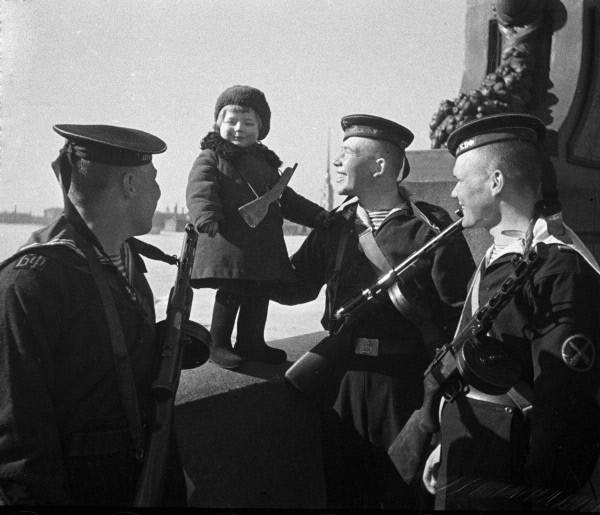
Baltic sailors with PPD (left and center) and PPSh (right)
In 1938, the more successful self-loading rifle of F.V. Tokareva SVT-38. It was distinguished by greater simplicity and reliability, thanks to which it was produced until 1945. The Red Army received more than 1,6 million SVT-38 and was actively used as a weapon for infantry, snipers, etc. However, the Tokarev rifle was more complicated and more expensive than the Mosin rifle, which again did not allow for a complete rearmament.
In parallel, there was a development of submachine guns. In 1941, the new PPSh-41 went into production, and later it was supplemented with the PPS-42/43 product. These samples combined high fire performance and ease of production, which led to the well-known consequences. During the war years, approx. 6 million PPSh and about 500 thousand PPS. The massive release of such weapons made it possible to gradually re-equip most of the Red Army soldiers, increasing the firepower of the infantry units.
However, even the massive PPSh and PPSh could not oust the pre-war "Trilinear". Moreover, during the war, it underwent modernization - in 1944 a new version of the carbine appeared. Rifle production mod. 1891/30 turned off only in 1945, and carbines were produced until the end of the decade.
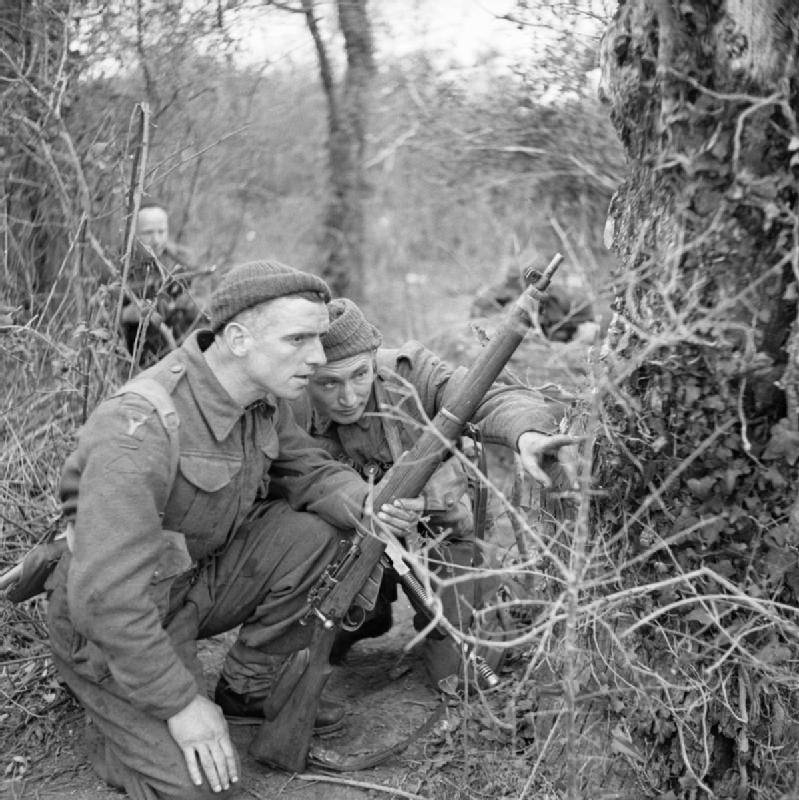
British scouts in Italy, 1944. A soldier holding a Lee-Enfield rifle. Photo Imperial War Museum
The Soviet army finally abandoned the Mosin rifle with the advent of a new complex of weapons, which included a Simonov carbine and a Kalashnikov assault rifle. Then these samples were supplanted by the submachine guns of the war.
British rearmament
In 1895, Great Britain mastered the production of the new Lee-Enfield magazine rifle, and in the following decades, this weapon underwent several upgrades. After the outbreak of World War II, new modifications appeared - the simplified rifle Rifle, No.4 Mk I and the landing rifle Rifle, No.5 Mk I. Over the entire production period, until the fifties, more than 17 million Lee-Enfield rifles of all modifications were manufactured ...
Before the war, the British army showed no real interest in self-loading rifles, and work on submachine guns began only in 1940. The Lanchester, a copy of the German MP-28, was the first example of this kind. Approx. 100 thousand of such products. In 1941, STEN entered service with an extremely simple design. Thanks to this, before the end of the war, they managed to release approx. 4 million submachine guns.
The mass production of submachine guns of a number of modifications made it possible to re-equip a significant part of the combatant army's combat units. At the same time, Lee-Enfield rifles remained of great importance and continued to be massively used. The transition to the modern self-loading rifle L1A1 began only in 1957.
US development
Since the beginning of the XX century. The main weapon of the US Army was the Springfield M1903 rifle. Despite the emergence of newer and more advanced models, it remained in the series until 1949. By this time, more than 3 million rifles were produced, and during the Second World War, production was significantly increased.
Back in the late twenties, the American army became interested in self-loading and automatic systems. According to the results of the competition, the M1936 Garand self-loading rifle was adopted in 1. By the beginning of the war, this rifle was able to press the old M1903, although there was no talk of a complete replacement yet. Almost until the end of World War II, the M1 and M1903 were used in parallel, but the number of Garads grew steadily and during the war equaled the number of Springfield and then surpassed it.
In 1938, the US Army entered the J. Thompson submachine gun, which was later developed. Until the end of the war, they managed to produce more than 1,2 million of these products in several modifications. Then a simpler and cheaper M3 appeared, manufactured in more than 600 thousand pieces.
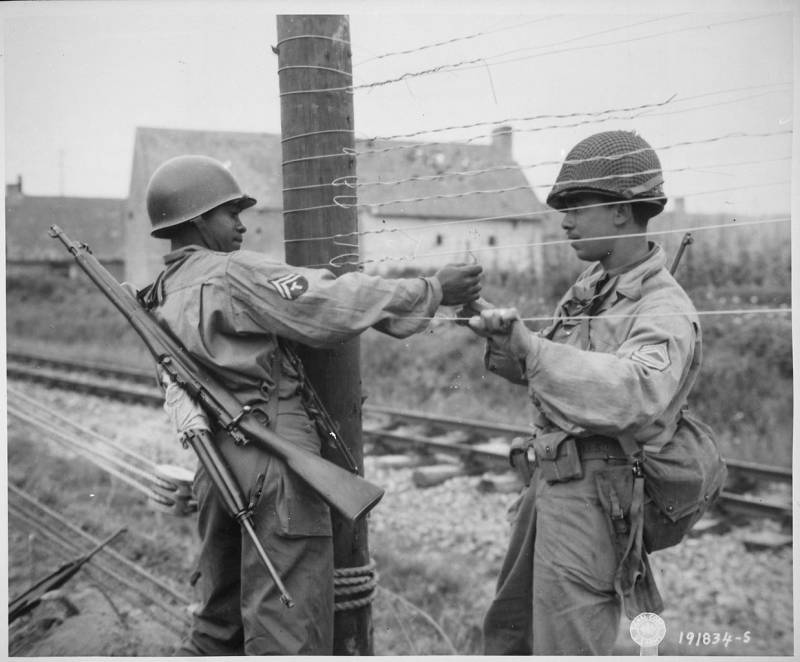
US soldiers repairing a fence, France, July 25, 1944. Both fighters are armed with M1 Carbines. The soldier in the foreground also carries a Springfield M1903 rifle. Photo by NARA
Since 1941, the M1 Carbine and its modifications have been produced, designed to replace rifles in some roles. This weapon turned out to be quite successful, simple and cheap. Until the end of the war, more than 6,2 million units were delivered to the army.
By the early forties, the Springfield M1903 rifle had lost its status as the main and most massive infantry weapon. In the future, several samples fought for this title at once, produced in a large series. It is curious that Springfield, unlike some of its replacements, is still in service with the United States - although it is used in extremely limited niches.
German approach
Since the end of the XIX century. the German army used the Gewehr 98 rifle and its various modifications. Another modernization was carried out in the mid-thirties, resulting in the Karabiner 98 Kurz (Kar 98k) carbine. By the beginning of World War II, they managed to produce a large number of such products and make them the most massive infantry weapon. The production of carbines continued until 1945; was made approx. 14,6 million units
In Germany, the original structure of the rifle squad was used. Its center was a machine gun, and other soldiers were supposed to protect the machine gunner and ensure his effective work. In this role, the shooters could use a magazine carbine and, as it was believed, did not need another weapon.
However, already in 1941, the Gewehr 41 self-loading rifle was adopted, which made it possible to increase the rate of fire and firepower. No more than 145 thousand of these rifles were produced, after which the more advanced Gewehr 43, made with the borrowing of Soviet ideas, went into the series. The number of such weapons exceeded 400 thousand pieces.
Several types of submachine guns were produced in a relatively large series. The most popular and famous was the MP-38/40, produced in an amount of at least 1,1 million units. However, such a weapon was not considered for a long time as a replacement for the Kar 98k. It was used as a means of self-defense for officers, crews of military vehicles, etc.
In 1942, the German army received a few MKb 42 (H) carbines, and in 1943, supplies of more advanced MP 43/44 began, later becoming StG 44. Such weapons, unlike submachine guns, were considered as a replacement for magazine carbines and self-loading rifles.
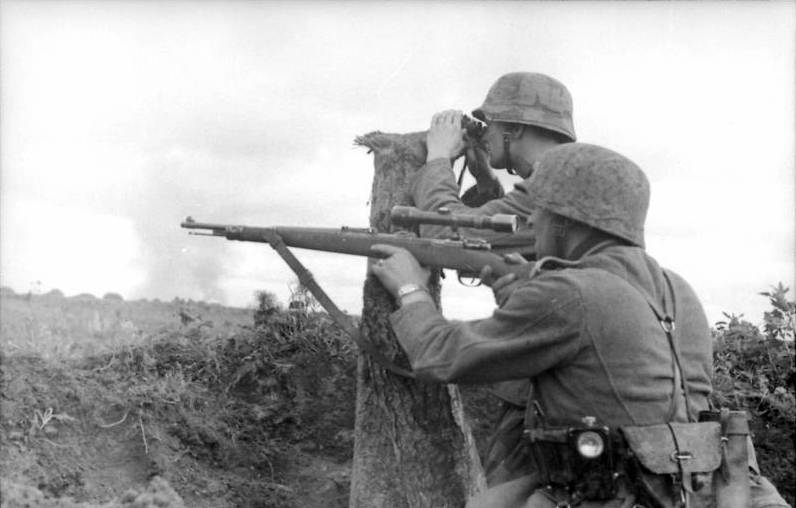
German sniper with Kar 98k, June 1942. Photo by the German Bundesarchive
A specific feature of the German infantry weapons system was the presence of many samples, often performing the same functions. This did not allow focusing efforts on specific projects - and did not allow new samples to reach the millionth series. As a result, none of the subsequent developments in terms of numbers caught up with the Kar 98k carbines.
After the war, numerous carbines were used by both Germany, and were also actively transferred to other countries. They continued to be used until the 50-60s. and was removed from service only in connection with the emergence of newer models, Soviet and NATO models.
Similarities and differences
All the main participants in World War II started the war with a large number of relatively old magazine rifles and carbines in their arsenals. As the war continued, the number and role of such weapons was reduced due to the emergence of new models - but it was never possible to completely decommission it. At the same time, several curious trends can be noted that distinguished the approaches of different countries.
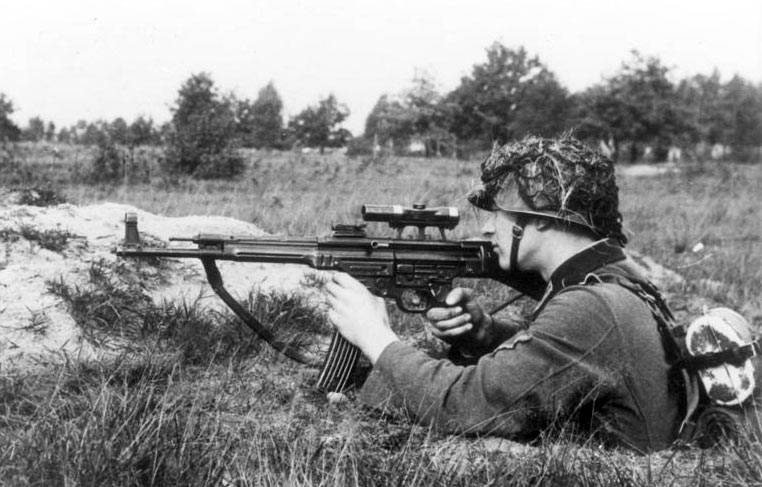
"Sturmgever" in battle. Photo of the Bundesarchive of the Federal Republic of Germany
The most progressive in this respect are the USSR and the USA. Even at the turn of the 20-30s. these countries began to look for ways to further develop infantry weapons and succeeded in this. By the beginning of the war, both countries had automatic infantry weapons of several classes and types. Subsequently, the production of self-loading and automatic systems continued, having a positive effect on the firepower and overall success of the armies. The USA and the USSR ended the war with the main weapons in the form of submachine guns and self-loading rifles / carbines.
The German military for a long time relied on machine guns and assigned other weapons a secondary role. However, already in 1940-41. they changed their minds and started developing new designs. For a number of objective reasons, the real results of such programs were obtained only in 1943-44, and this no longer allowed them to use their full potential. At the same time, Kar 98k carbines still retained an important place in the army.
At the very least, the British position looks ambiguous. Until 1940, the British army relied only on rifles and light machine guns, almost not paying attention to self-loading and automatic models. We had to make up for lost time already during the war and in conditions of a shortage of resources. However, all the problems were successfully dealt with, as evidenced by the production success of the STEN product.
The Second World War quickly showed that magazine rifles with manual reloading can no longer be the main weapon of the modern infantryman. More advanced systems such as submachine guns are needed to ensure adequate combat capability. It is easy to see that the countries that were the first to understand this and take into account when developing their weapons, in the end became the winners.
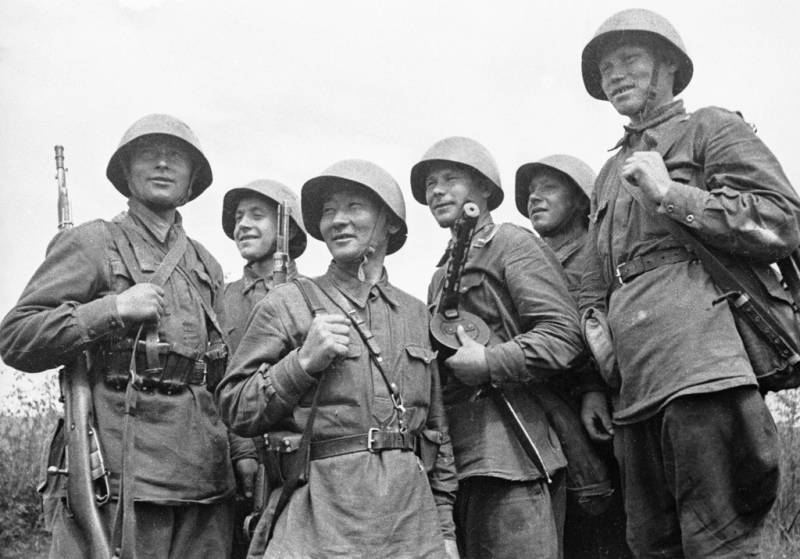
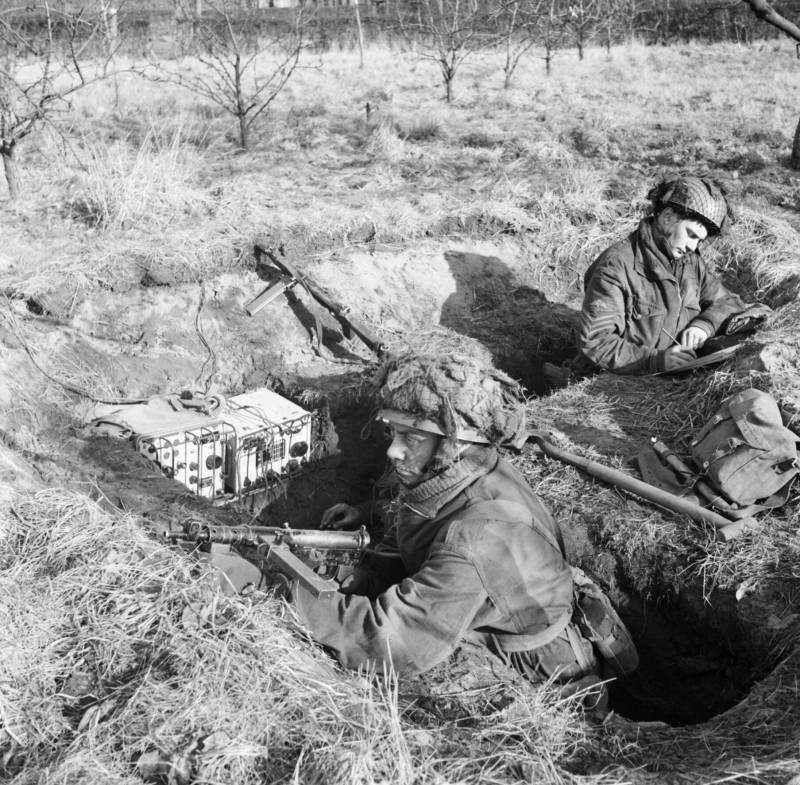
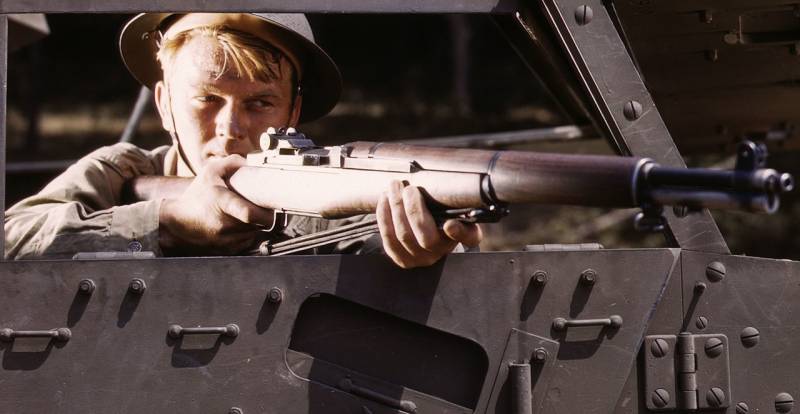
Information